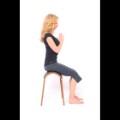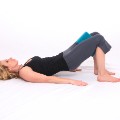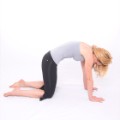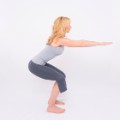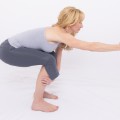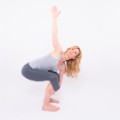Story highlights
- Breathing is natural, but there are ways to breathe better
- Many pro athletes train in techniques to increase mobility and prevent tension
Dana Santas is the creator of Radius Yoga Conditioning, a yoga style designed to help athletes move, breathe and focus better. She's the yoga trainer for the Atlanta Braves, the Philadelphia Phillies, the Tampa Bay Rays, Tampa Bay Lightning, Orlando Magic and dozens of pros in the National Football League, National Hockey League, National Basketball Association and Major League Baseball.
(CNN)From an early age, we're taught that breathing is part of our autonomic nervous system, like digesting food, so unless there's a problem, it's not something we need to think about. But, unlike digestion, we actually have the ability to control our respiration -- and for good reason. Arguably, the way we breathe has the power to impact every aspect of our health and wellness, from how we think and feel to how we move.
Many of us recognize the link between breathing and physiology, particularly during times of stress, but most don't realize its reciprocal impact on our overall posture and mobility. Bad breathing creates tension and immobility, and immobility and tension prevent good breathing. That's why teaching proper breathing biomechanics is the foundation of all my work with professional athletes.
How bad breathing hurts us
The quality of our breathing is governed by our ability to access the primary muscle of respiration: the diaphragm. It's a misconception that diaphragmatic breathing is reserved for deep breathing. It's actually fundamental to all functional breathing. And, the diaphragm's function, in simplest terms, is dictated by the position of your ribcage and spine and vice versa.
If, like most people, your breathing is primarily chest oriented and shallow, your ribcage will get pulled into a lifted and flared state that compromises diaphragm function, requiring chest, neck, and upper back muscles to act as "accessory" breathing muscles. This causes chronic tension that locks you into poor -- often painful -- posture with shoulders slumped forward, shoulder blades humped and your mid-back flattened.
What's more, when the diaphragm isn't being used properly for respiration, it becomes dysfunctional in its postural role, too, pulling into its attachments to your lumbar spine, causing disc compression. This chain reaction of tension from improper breathing doesn't just hurt and make it harder to move, it increases your risk of back, neck and shoulder injury.
You could spend multiple hours a day stretching and practicing "good" posture, but, because we take almost 1,000 breaths an hour, 24 hours per day, relief would only be temporary without correcting your breathing.
How to breathe better
"Just take long, deep breaths."
This is a common directive given by well-intentioned therapists, coaches, yoga instructors and the like. However, its effectiveness is predicated on actually knowing how to breathe properly.
Personally and professionally, my life -- and breathing -- changed dramatically four years ago when I took a "Postural Respiration" course through the Postural Restoration Institute. Previously, I had assumed I knew how to teach breathing, decrease tension and correct dysfunctional movement -- I was a yoga instructor, after all. But the course opened my eyes to proper breathing biomechanics as our most fundamental movement pattern and its ability to impact all other movement patterns.
According to the institute's creator, physical therapist Ron Hruska, "proper diaphragmatic breathing restores everything from alternating mechanics of dynamic movement and posture, like arm swing during gait, to our ability to handle sensory input."
With this knowledge, my breath work with clients evolved from a focus on relaxation to leveraging breathing for better movement, such as increasing pitchers' shoulder mobility, enhancing golfers' swing rotation and improving hockey players' shoulder girdle stability.
Consequently, I empower all my clients to understand how to breathe properly. This starts with a basic comprehension of the anatomy and action of the diaphragm, a dome-shaped muscle that attaches to your ribcage and lumbar spine. Upon inhalation, the diaphragm contracts and descends in the abdomen to increase intra-abdominal pressure, pulling air into the lungs. With exhalation, the diaphragm domes inside the ribcage, emptying the lungs. None of this can occur without proper position and movement of the ribcage.
When inhaling, your entire ribcage, including your chest, should expand without any lift from neck and shoulder muscles. What many people don't realize is that the most substantial movement, during inhalation, should occur in your lower ribs as they externally rotate (open out) and expand out to the sides. When exhaling, your lower ribs should internally rotate (close in), creating the necessary space for your diaphragm to dome inside your ribcage. If you place your hands on your low ribs while you take a breath, you should feel your hands move out and in.
Overcoming the effects of "bad" breathing takes training. You can experience results in as little as a few minutes, but, for a functional breathing pattern to hold, you need to train it. Here are five ways I train breathing for better movement. As you practice these exercises, keep in mind all of the mechanics of breathing explained above.
Seated fingertip breathing
Facilitates proper seated posture during breathing while also integrating a meditative focus
Sit upright on a stool or stability ball, trying to maintain the natural curves of your spine. Keep both feet on the floor hip-distance apart with toes pointing forward. With your hands together at the center of your chest, close your eyes and activate the muscles below your shoulder blades (lower trapezius) to pull them downward. You should feel the uppermost back muscles that run into your neck (upper trapezius) relax. When you inhale, gently push the pads of your fingers into each other in sequence, starting at your pinkies, for a count of five. Repeat on exhale. Pause after exhaling without taking another breath for another five count. Focus your attention on the movement of your ribcage as you breathe. Inhale and expand your ribcage, especially at its base. Exhale as you internally rotate your low ribs and drop your ribcage toward your waist. During the pause, keep your side waist muscles (obliques) and low, deep core (transverse abdominus) engaged to keep the ribcage down. Avoid vertical movement as you inhale -- no shoulder shrugging or collarbones lifting. Repeat for 10 breaths. Note: If you find you can continue exhaling after a five count, increase your exhalation time as much as necessary to completely empty your lungs before pausing.
Bridge breathing
Trains breathing with complete core engagement and pelvic/hip alignment
This is the starting position all of my athletes use to train their breathing during warmups. Begin on your back with your knees bent and feet on the floor hip-distance apart about 6 inches from your bottom. Place a foam yoga block or rolled towel between your legs to engage inner thighs (adductors) and avoid your hips externally rotating and knees splaying out. With your arms at your sides, attempt to slide your shoulder blades down, as you did in the first breathing exercise, to relax your upper back and neck. On an exhalation, as you draw your low ribs in and down toward your waist, engage your low, deep core to initiate lifting your hips approximately 4 inches off the floor. Avoid arching your low back. Maintain the bridge posture by activating the muscles of your buttocks and core. Hold this position as you breath in the same pattern as the preceding exercise: five-count inhale, five-count exhale, five-count hold. Repeat for two sets of five breaths each.
Angry cat breathing
Works on ribcage retraction while breathing to release overused chest muscles
Take an all-fours position with your hips stacked above your knees, ankles aligned horizontally with your feet, and shoulders above your wrists. With an exhalation, drop your ribcage down toward your waist as you engage your low, deep core and tilt your pelvis to tuck your tailbone. As you inhale, retract your ribcage and round your spine, like an angry cat. Hold this position while you continue to breathe as deeply as possible, directing inhalations into your back. You should feel that your core is very engaged, but your chest is relaxed. After three breaths, release briefly, then repeat.
Flowing chair
Synchronizing breathing and movement with proper ribcage mechanics
From standing with feet hip-distance apart, exhale as you drop your ribcage, engaging your core, and sitting back into a gentle squatting position with your arms out in front at shoulder height. Inhale as you rotate your arms overhead, shoulder-distance apart, while you come back up to standing. Repeat the movement for a total of five times, flowing with your breath: exhaling into the squat and inhaling to stand with arms overhead. Maintain breathing at a five-count inhale and five-count exhale. Do not allow your feet to turn out; keep them planted with toes pointed forward.
Modified twisting chair
Leverages the alternating and reciprocal nature of breathing/ribcage biomechanics during twisting to facilitate better thoracic spine (mid-back) movement.
Start in the preceding chair pose, but use an exhalation to squat back and down deeper to bring your hips level with your knees, if possible. Place your left hand on your right shin, making a right angle with your elbow. Inhale as you reach your right arm forward and rotate from your shoulder, mid-back and ribcage to twist open to the right, reaching your hand upward. Keep your low-back, hips, and knees level and neutral. Hold for five breaths, using your respiration to facilitate the twist. Focus your inhalations on the open side of your ribcage (the side you're turning to) and exhalations on the opposite side, where you can use side waist muscles to internally rotate your ribs and enable further rotation of the ribcage and mid back. Unwind and practice the rotation to the left.
In my opinion, if there is any human super power, it's breathing. Not only is it the strongest link between life and death, it gives us the power to change the way we think, feel and move. Ask any of my pro athlete clients and they'll tell you that the way they breathe has everything to do with the way they perform. If you want to take your game -- your life -- to the next level, train your breathing.






